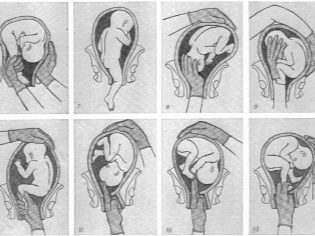Can water withdraw long before the start of contractions and what to do?
Amniotic fluid performs several important functions, but first of all they provide protection for the baby and dampen its movements inside the mother's womb. In normal childbirth, water usually leaves during the first phase. The ideal option is the rupture of amniotic fluid after labor, with the full disclosure of the cervix. But sometimes childbirth does not begin with contractions, but with a rupture of the sac of sac and the discharge of water. How to be if the water is diverted, and there are no contractions, we will tell in this article.
Causes and signs of effusion
According to statistics, 10% of pregnant women face the premature outpouring of water, who informed their baby before the due date. In almost half of premature births, the process of giving birth to a baby also does not begin with contractions, but with the discharge of amniotic fluid. It is noteworthy that in women in labor in whom the first pregnancy ended with the discharge of water before the development of labor activity, in 35% of cases the scenario repeats with accuracy during the subsequent pregnancy.
The outpouring of amniotic fluid can be massive, when it is immediately poured a lot, and can be gradual, when the water due to a small rupture of the membranes of a phlegm gradually leaks. It is difficult to determine such effusions independently, and therefore Women are strongly advised that when the nature of the discharge changes, it is imperative to inform the attending physician about this.
Before childbirth in the body of a woman, special enzymes are produced that soften the shell of the fetal sac. It may burst early due to numerous reasons.
- Ascending mother infections (infectious lesions of the genital tract) - the most common cause of premature pregnancy.
- Narrow pelvis and incorrect position of the fetus in the uterus - This reason is more typical of cases of full-term pregnancy. In this case, there is no tight fit of the presenting part of the child’s body to the pelvis, no separation into the so-called front and rear waters is created, almost the entire volume of amniotic fluid accumulates below and departs. But the risks to the fetus and women with such a reason are minimal.
- Cervical insufficiency - this reason usually accompanies premature birth, but may also be the first signal of the beginning of the birth of a full-term baby.
- Interference from outside - We are talking about invasive diagnostic methods. Some women mistakenly believe that the discharge of water can trigger examinations at the gynecologist or sexual intercourse.
- Woman ill-being - Speech about alcohol abuse during childbirth, about smoking during this crucial period, as well as about women with severe anemia, preeclampsia, edema, weight deficit or obesity.
- Bearing twins or triplets.
- Traumatic rupture of fetal bladder - the fall of a woman on the stomach, on the buttocks, on the back (at any stage of pregnancy).
How to understand that the water has departed, women are told in antenatal clinics, since this is indeed a very important skill. With a complete rupture of the fetal bladder, rupture occurs in a large volume, the stomach immediately visually becomes smaller. It is not excluded the discharge of mucus plug simultaneously with the waters or some time before them.
If the ruptures of the sac of sac are small and lateral, then the waters flow gradually, gradually. Sometimes we are talking about a few drops. You can pay attention to this after a long stay in the prone position - water accumulates in the genital tract and their waste becomes more noticeable.
If there is a suspicion of water leaking, it is imperative to contact a medical institution, since this condition may threaten the life of the child and the mother. At home, you can spend pharmacy amniotests, but its accuracy leaves much to be desired.
When should childbirth begin?
If the water is still gone, do not need to panic. Normally, the contractions should begin in about 3–4 hours. This period is considered optimal. But the limits of the permissible latent period are quite wide.
- If the term of gestation 24 to 28 weeks It may take a month before delivery from the moment of discharge. Naturally, this whole period, if the doctors decide to wait, the woman will have to spend on bed rest in the ward with increased sterility measures. An important condition is that not all waters should move away.
- With the term of pregnancy from 29 to 37 week contractions develop on their own within 24 hours in about half of the women, the rest can have a longer waiting period - up to a week, which, again with incomplete use and the mother’s absence of infections, the woman will have to spend in the ward under the supervision of a doctor.
- From week 38 from the moment of discharge to the onset of contractions, it usually takes less than 12 hours for half the women. The rest of the latent period can last from 24 to 72 hours.
After an amniotomy (puncture of the fetal bladder), it usually takes less time before the start of contractions. Without stimulation, they begin within 3-9 hours.
Another question is that sometimes waiting for a long latent period is simply dangerous. Risks for the kid, deprived of protective waters, are too high. And because the question of delivery is put an edge almost a few hours after the woman’s admission to the hospital.
In normal childbirth, after timely discharge of amniotic fluid, the child remains without water for a certain amount of time. In this case, nature has provided a number of compensatory mechanisms. But a baby cannot be without water for longer than 12 hours without consequences for health. The safest period is considered 6 hours. After this time, doctors need to decide what to do next to save the child and his mother.
Danger
What is so dangerous anhydrous period for the baby and the mother, why you can not safely wait for the end of the latent period and the beginning of independent fights?
The most important and most dangerous danger lies in the development of an infection that will strike the baby, the inner lining of the uterus. This complication occurs in about a third of cases, if the baby is in the uterus without water for more than 12-24 hours. For a child, it faces serious consequences, often death. For the mother, such a state threatens to remove the reproductive organ and the inability to conceive, bear and give birth to the child in the future. Infections in the uterus during pregnancy do not fall due to mucus plug and amniotic fluid, creating an almost sterile environment. If there is no water and cork, the probability of infection with staphylococcus, streptococcus and other bacteria and viruses is high.
For premature babies, if the waters are gone before 37 weeks of gestation, the situation is complicated by the likelihood of respiratory distress syndrome. In 70% of cases, it is this complication that causes the death of a premature baby.
To avoid such a complication, doctors need to determine the reasonable limits with great accuracy - to extend the latent period as much as necessary to stimulate the production of surfactant in the lungs of crumbs by hormones;
A no less formidable complication of the anhydrous period is fetal hypoxia.It occurs due to compression of the umbilical cord and placental abruption, which occurs quite often. The danger of acute oxygen starvation lies in the likelihood of brain damage, the central nervous system, and child death. Often, after a long anhydrous period, the child develops cerebral palsy, ischemic brain damage, the severity of which is commensurate with the degree of hypoxia and the duration of the anhydrous period.
Often, childbirth after the discharge of water flow with anomalies. By itself, early discharge of amniotic fluid is considered a complication of pregnancy and the labor process. However, the lack of water very often leads to the development of contractions, but very weak, insufficient for opening the cervix and the birth of the baby. Another common complication of childbirth after the outpouring of waters is rapid delivery, rapid, in which the probability of birth injury is very high.
Extremely dangerous for the baby is the formation of cords inside the uterus with a long anhydrous stay. These thin and durable threads can lead to the self-amputation of the limbs of the fetus.
Woman's actions
With the discharge of amniotic fluid, or even suspicion of this, an ambulance should be called. Even if a pregnant appointment with a doctor’s appointment is scheduled for tomorrow, it’s impossible to wait. And even more so you can not stay at home to wait for the start of bouts. The latent period can be long, and time is not in favor of the child.
If the waters are not clear, the woman should note what color they are and be sure to notify the doctor in the maternity hospital where the emergency room will take her.
The color of the water is essential to the choice of further tactics. If the waters are clear, it is likely that there is still time, the child feels good, if the waters are green, dark, gray, with a swampy unpleasant smell, this may indicate development of an infection, hypoxia, due to which the child has rectum came out original cal meconium, dyed water in green or dark color. Water with blood is often a sign of placental abruption.
In all these situations, an urgent decision on delivery is made, the surgical method of caesarean section is preferred.
In anticipation of the ambulance crew, a woman needs to lie on her side, to avoid standing upright, sitting.
It is important to make sure that all the documents and things necessary for the delivery have been prepared. It is necessary for a woman to have with her a passport, a policy of compulsory health insurance, an exchange card from the antenatal clinic with all analyzes and ultrasound protocols for the entire period of pregnancy.
You do not need to drink medicine - any medication can harm, try to squat more, bend down to cause contractions.
How do doctors act?
Immediately after they bring you to the hospital, doctors will have to quickly make the right decision about what to do next - cause contractions and stimulate childbirth, perform a caesarean section, or enter a latent period and try to maximize the pregnancy.
For a start, they will confirm the fact of rupture of the membranes. A woman will be examined, an ultrasound scan will be done with a change in the amniotic fluid index, they will be tested. Today, the PAMG-1 test (Amnishur) is used for diagnostics, its accuracy is over 99%.
If the fact is not confirmed, the woman will be calmed down and sent home, since it is too early to give birth. If the diagnosis confirms the rupture of the membranes, the condition of the woman and the child will be assessed.
It is important to determine as accurately as possible the estimated weight and height of the fetus, the size of its head, the size of the woman's pelvis, the degree of readiness of her cervix for labor.
If the gestation period is less than 36 weeks, most often they try to do everything possible to wait at least a little, to give the baby an opportunity to accumulate surfactant in the lungs. If there are contraindications to waiting tactics, immediately decide the issue of delivery.
If the pregnancy is full-term, but the gestation period is considered to be from week 37 or more, the waters were clean, the woman is sent to the antenatal ward and wait several hours. During this time, she is examined for infections, and will also monitor the condition of the baby through CTG.
If contractions are too weak or after 6 hours they are not there, this is a reason to stimulate labor. Oxytocin, a hormone that enhances uterine contractions, is added to a woman. If after another 6 hours of complete cervical dilatation did not occur, the decision is made to conduct an emergency cesarean section.
If the doctors decided that the birth now for the child can be fatal (risk of respiratory distress syndrome) and the decision on prolongation is made, then the woman is placed in a separate ward equipped with germicidal lamps. They clean it 4-5 times a day, bed linen is changed once a day, diaper linings are changed to clean and sterilized once every 3 hours. It is prescribed strict bed rest and round-the-clock monitoring of the condition of the fetus.
findings
Doctors will only be able to maintain a pregnancy after the waters drain, if there are no contraindications for staying in the latent period. Such contraindications include infections, inflammatory processes, various complications and pathologies of pregnancy.
All women whose babies have reached a weight of 2,600-2,700 g or more from 37 weeks of gestation and upwards try to give birth without waiting for many days. To give birth as soon as possible (usually by caesarean section) will have to women whose children weigh less, and the term is less, provided that there are signs of infection or suspicion of fetal distress - rhesus-conflict, hypoxia, signs of violations of CHT.
The discharge of amniotic fluid can have dire consequences for both the child and his mother. That is why it is important to act without panic, but clearly and quickly.
Just in case, a woman from 32-34 weeks should prepare a bag with the necessary things and documents for hospitalization, put it in the corridor, not far from the exit. If the waters recede, the outcome of pregnancy and childbirth depends on how quickly she will be in the hospital and will be examined.
From 32 weeks you should not wear colored underwear, and also sleep on colored bedding. The very fact of discharge or leaking of water on them can be detected, but to establish the color or shade of the water when pouring onto blue, green or red bedding will be almost impossible. It is best to use white linens and panty liners that will help with determining the nuances of the color range of amniotic fluid.
There is not a single harbinger of the discharge of waters. Not a single symptom will manifest and indicate that the fetal bladder will soon burst. This happens all of a sudden, unexpectedly, sometimes even without apparent reasons and prerequisites. A woman needs to be extremely ready for such an event. With the right actions of the woman in labor and the right medical tactics (active or passive, waiting), everything ends well, and quite healthy children are born. The likelihood of complications will increase as time passes.
How the beginning of childbirth passes and waters depart, look in the following video.





























